Glossop, Derbyshire
Up to 1834
Glossop Township workhouse was erected in 1832-4, just before the passing of the 1834 Poor Law Amendment Act. Poor law administration at that time was in the hands of the Vestry meeting which, in January 1833, accepted specifications and plans for the building of a workhouse and invited tenders for its construction. On 20th February 1834 the Vestry ordered that:
After 1834
Glossop Poor Law Union formally came into existence on 5th December 1837. Its operation was overseen by an elected Board of Guardians, 16 in number, representing its 2 constituent parishes as listed below (figures in brackets indicate numbers of Guardians if more than one):
County of Derby: Glossop, including Glossop Dale, Charlesworth Churnal, Hadfield and Dinting, Padfield, Somondley, and Whitfield (14); Ludworth and Chisworth (2).
The population falling within the Union at the 1831 census had been 9,631. The average annual poor-rate expenditure for the period 1836-38 had been £1,075 or 2s.3d. per head of the population.
The new Glossop Board of Guardians took over the recently built Township workhouse whose location and layout can be seen on the 1919 map below.
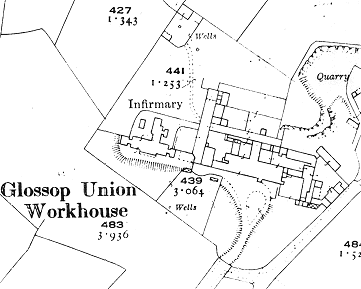
Glossop workhouse site, 1919.
The main workhouse building was a two-storey stone structure running east-west, with an extension at its western end.
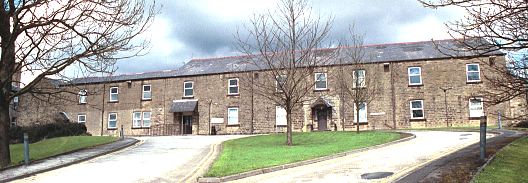
Glossop main building from the south, 2001.
© Peter Higginbotham.
An infirmary was erected to the west of the workhouse. The original structure, dating from 1896-7, had 40 beds and cost £5,000. The building was greatly extended in 1926-7 at a cost of £7,500.
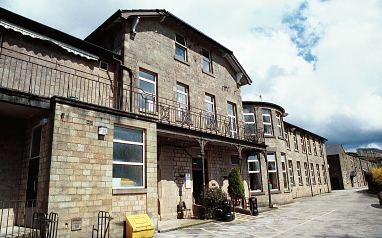
Glossop infirmary from the south-west, 2001.
© Peter Higginbotham.
A new laundry was erected at the north of the workhouse in 1902, and the kitchens at the west of the laundry were rebuilt in 1920.
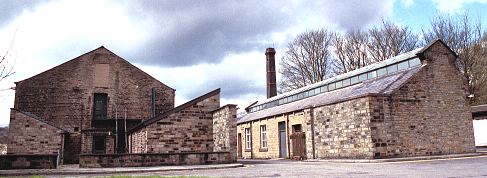
Glossop laundry block from the south-east, 2001.
© Peter Higginbotham.
Other buildings on the site included piggeries and casual wards for vagrants. It is believed, however, that tramps were sent to perform work in the adjacent quarry rather than in work cells in the workhouse itself.
All workhouse inmates were required to wear a workhouse uniform, which for able-bodied women consisted of a blue and white striped dress, apron, shawl, and bonnet or cap which at Glossop had a distinctive pointed shape. At some workhouses inmates made their own clothing which provided useful work and also saved the union money.
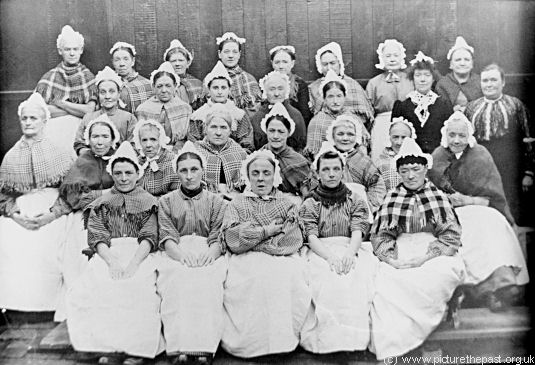
Glossop workhouse women's uniforms.
© Mrs E Bennet and www.picturethepast.org.uk.
The workhouse later became known as Glossop Public Assistance Institution and then under the National Health Service as Shire Hill Hospital. The hospital closed in 2018 when its services were transferred to Tameside General. In 2023, plans were revealed for redevlopment of the site, including restoration the former workhouse building and its conversion into ten new terraced homes
Staff
Inmates
Records
Note: many repositories impose a closure period of up to 100 years for records identifying individuals. Before travelling a long distance, always check that the records you want to consult will be available.
- Derbyshire Record Office, New Street, Matlock, Derbyshire. Virtually no local records survive.
Bibliography
- None.
Links
- None.
Acknowledgment
- Picture of workhouse uniforms is used by kind permission of www.picturethepast.org.uk
Unless otherwise indicated, this page () is copyright Peter Higginbotham. Contents may not be reproduced without permission.


